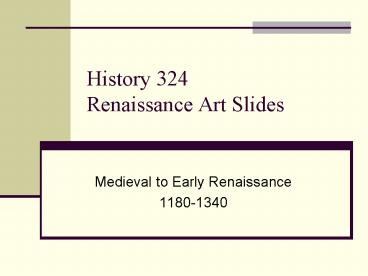History 324 Renaissance Art Slides - PowerPoint PPT Presentation
1 / 22
Title:
History 324 Renaissance Art Slides
Description:
Byzantine art in the Middle Ages divided anatomy into clearly demarcated ... (Corinthian columns) and medieval traditions in Western Europe (Gothic arches) ... – PowerPoint PPT presentation
Number of Views:123
Avg rating:3.0/5.0
Title: History 324 Renaissance Art Slides
1
History 324Renaissance Art Slides
- Medieval to Early Renaissance
- 1180-1340
2
Italy and the major Italian city/states of the
Renaissance Artistic experimentation and
innovation began especially in Pisa, Florence,
Siena, Lucca, Assisi, and Rome, and later spread
to Venice, Milan, Naples, and other cities
3
Byzantine (Greek) artist Crucifixion 11th
century Daphni, Greece Byzantine art in the
Middle Ages divided anatomy into clearly
demarcated sections and featured shimmering gold
backgrounds and Christian themes Byzantine styles
came to Western Europe after the 1204 Sack of
Constantinople by Western crusaders
4
School of Pisa Cross No. 15 Late 12th
Century Pinacoteca, Pisa Christus triumphans
(Christ triumphant style) Byzantine (Greek)
influence obvious in this medieval Italian art
from Pisa (a center of maritime trade)
5
School of Pisa Cross No. 20 1230 Pinacoteca, Pisa
6
School of Florence Cross Late 12th century Uffizi
Gallery, Florence Christus triumphans style The
soaring Christ with six crucifixion detail
paintings
7
Bonaventura Berlinghieri, Madonna and
Child 1228 Byzantine influence
8
Bonaventura Berlinghieri, St. Francis 1235 Pescia
Pictorial representation of life of St. Francis
only nine years after his death Byzantine
influence in architecture shown in scenes, gold
background, and Francis saintly pose. Romanesque
interest in emotion.
9
Cimabue, Enthroned Madonna and Child 1280 Uffizi
Gallery, Florence Combination of Byzantine and
Romanesque (medieval) style of Western
Europe. Mary is shown in an out of time
heavenly scene, and points to Jesus.
10
Styled after ancient Roman art Note especially
reclining St. Anne and Roman-style drapery and
architecture
Pietro Cavallini, Birth of the Virgin mosaic,
1290s, Santa Maria in Trastevere, Rome
11
Nicola Pisano Pulpit in Pisa Cathedral 1259-60 Pis
a Medieval sculpture in the early Renaissance
was influenced by Roman styles (Corinthian
columns) and medieval traditions in Western
Europe (Gothic arches). The eagle represents St.
John the Evangelist
12
Nicola Pisano, Pulpit panel detail, Birth of
Jesus and Adoration of Shepherds (1260) Note
Roman drapery and reclining Mary. All figures are
marble.
13
Nicola Pisano, Daniel (also known as the
classical virtue Fortitude) Pisa Cathedral
Pulpit 1260 A return to the nude sculpture of
classical Greece and Rome was a new development
of the Italian Renaissance. This heroic figure of
Daniel is an adaptation of the Roman Hercules,
and thought to be the first nude
14
Arial view of Siena, central piazza, and city
hall (with tower)
15
Siena Cathedral designed (in part) by Giovanni
Pisano (Nicola Pisanos son), 13th century
16
Ambrogio Lorenzetti, The Effects of Good
Government, 1338, Siena This fresco cycle is in
the Siena town hall and would have been visible
during all council meetings
17
Ambrogio Lorenzetti, The Effects of Good
Government, 1338, Siena
18
Ambrogio Lorenzetti, The Effects of Good
Government, 1338, Siena
19
Ambrogio Lorenzetti, The Effects of Good
Government, 1338, Siena
20
Ambrogio Lorenzetti, The Effects of Bad
Government 1338 Siena town hall
21
Ambrogio Lorenzetti, The Effects of Bad
Government (Countryside) 1338, Siena
22
Ambrogio Lorenzetti, Presentation in the
Temple 1342 Uffizi Gallery, Florence
This egg tempera panel shows vivid colors and the
mature Lorenzetti style (and influence of Giotto)
near the end of his life. The Renaissance has
begun.






























